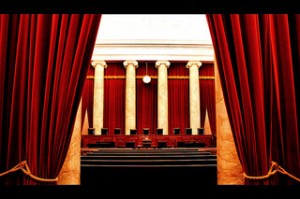The Supreme Court’s decision in Reed v. Town of Gilbert, Arizona could upset sign codes nationally. Most sign codes, like Gilbert’s, include different categories of temporary signs. It makes sense, for example, to give people more time to remove thousands of election signs and less time to remove a few yard sale signs. In this case the Court will decide whether local governments may regulate temporary directional signs differently than other temporary signs. The Court could rule, practically speaking, that all temporary signs must have the same time, place, and manner requirements. IMLA joined the State and Local Legal Center’s (SLLC) amicus brief asking the Court not to go that far.
Most sign codes, like Gilbert’s, include different categories of temporary signs. It makes sense, for example, to give people more time to remove thousands of election signs and less time to remove a few yard sale signs. In this case the Court will decide whether local governments may regulate temporary directional signs differently than other temporary signs. The Court could rule, practically speaking, that all temporary signs must have the same time, place, and manner requirements. IMLA joined the State and Local Legal Center’s (SLLC) amicus brief asking the Court not to go that far.
Gilbert’s Sign Code includes temporary directional signs, political signs, and ideological signs. After being notified that its temporary directional signs announcing the time and location of church services were displayed longer than allowed, the Good News church sued Gilbert. The church claimed Gilbert’s Sign Code violates the First Amendment because temporary directional signs receive the less favorable treatment (in terms of size, location, duration, etc.) than political signs and ideological signs.
The Ninth Circuit ruled that Gilbert’s Sign Code does not violate the First Amendment because the distinctions between the three sign categories are “content-neutral”; all signs in each category are treated the same regardless of their content even if the three categories of signs are treated differently. Because the lower court concluded that the sign categories are “content-neutral,” it applied intermediate scrutiny rather than strict scrutiny. The different treatment of temporary signs would not serve a “compelling” government interest as strict scrutiny requires, but does serve a “significant” government interest as intermediate scrutiny requires.
The SLLC’s amicus brief argues that Gilbert’s Sign Code does not violate the First Amendment. Sign codes with multiple categories of temporary signs, usually classified by function, with their own time, place, and manner requirements, are common. And the fact that a temporary sign must be read to determine what kind of temporary sign it is does not render a sign code “content-based.” Finally, even when the three categories of temporary signs at issue in this case are compared with each other, they are regulated by purpose, rather than by content, meaning strict scrutiny should not apply.
Bill Brinton, Rogers Towers wrote the SLLC’s brief which was also joined by the National League of Cities, the National Association of Counties, the International City/County Management Association, the United States Conference of Mayors, the American Planning Association, and Scenic America.
Image courtesy of Flickr by Phil Roeder (creative common license, no changes made).
